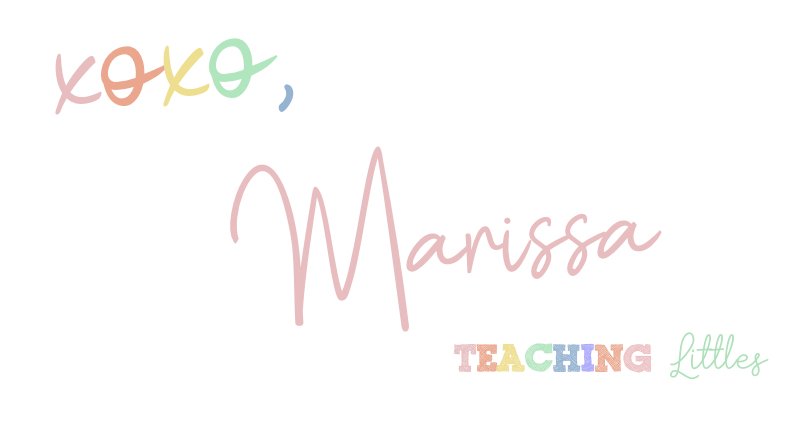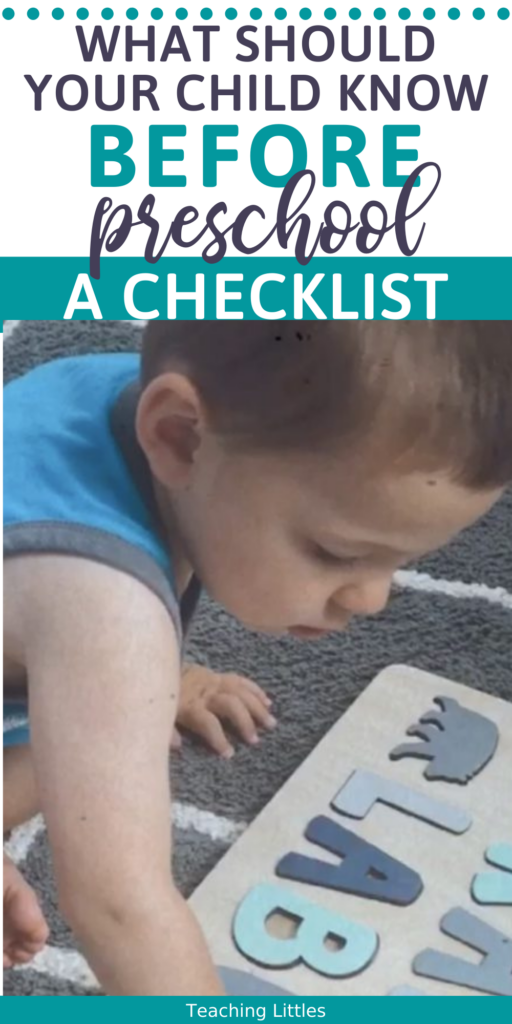The school year will be here before we know it and a top question on every parents’ mind is what should my child know before preschool?
While there are several checklists for preschool floating around the internet, there are very few that actually take into account your preschooler as a whole. When searching for a preschool checklist, it is crucial to find one that encompasses all skills and abilities that your soon-to-be preschooler should possess.
I put together the most comprehensive preschool skills checklist that you will find. Following this list will ensure that your child is more than ready for preschool this fall.
Scroll down to download the free printable version of this checklist.
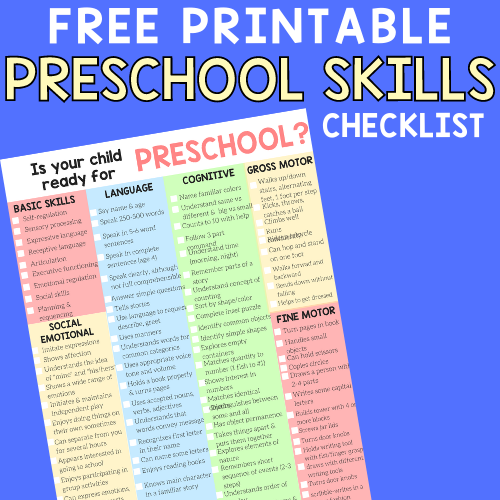
Preschoolers Can Still Learn Through Play
Although your child is transitioning from toddler to preschooler, they can still develop and practice new skills from structured and unstructured play. A lot of what they learn, you won’t even realize that you’re teaching them!
However, once your child is 3 years old, they can begin to learn from more structured activities based on appropriate concepts that are able to be learned and mastered at this age.
Does My 3 Year Old Need Preschool?
I found preschool to be so beneficial for my daughter at this age. The socialization is one of the biggest benefits of a preschool program.
They’ll be exposed to so many new opportunities that may not be available at home like different toys and learning materials, daily structure and routines, learning to respect their teachers, various educational activities, and much more.
I don’t believe that preschool at 3 years old is absolutely necessary and your child will be fine without it. However, I would enroll a 4 year old in some sort of program to get them prepared for Kindergarten.
Some schools or daycares offer full day or half day preschool and you can choose whether your child goes every day or a few times a week.
What is Preschool Readiness?
Preschool readiness is essentially a child’s ability to make a smooth and successful transition to preschool and all of its routines and expectations.
These skill expectations include social/emotional, language, play, gross motor, fine motor, cognitive, health and safety, and self care skills.
If your child has these skills mastered it will make the transition much easier. With some preparation, parents can help their child develop and nurture preschool readiness.
What is the Most Important Readiness Skill for Preschoolers?
Contrary to popular belief, being able to read, write, or do math are the least important skills that a preschooler needs in order to be ready to start school.
The most important skills have nothing to do with their academic skills and everything to do with emotional development.
The children who are most ready for preschool are independent, confident, and, above everything else, curious.
Why Is Preschool Readiness Important?
When your child shows signs for preschool readiness this will allow your child’s preschool teacher to expand and further develop their skills.
Having at least a basic proficiency before entering preschool will allow your child more success and opportunity to further develop in these areas.
How to Know if Your Child is Ready for Preschool
To be honest, many preschool teachers agree that a child’s preschool readiness is actually more dependent on his or her individual personality and temperament than her so-called “academic” abilities.
If your child is showing signs of independence and social/emotional readiness your child is likely ready for beginning preschool. (That is if Mama is ready.)
What basic skills are required to develop preschool readiness?
In order to develop preschool readiness skills your child should possess certain building blocks ahead of time. Before beginning preschool you should assess if your child possesses these basic building blocks:
- Self regulation – the ability to regulate emotions
- Sensory processing – can your child handle varying levels of noise, light, movement & etc
- Receptive language (understanding) – does your child understand basic commands?
- Expressive language (using language) – can your child express themselves or handle simple conversation.
- Articulation – Can other people understand your child’s words?
- Executive Functioning – these refer to your child’s reasoning and thinking skills
- Emotional development/regulation – does your child understand emotions and possess a basic ability to regulate their own?
- Social skills – when around others can your child follow basic social interactions such as sharing?
- Planning and sequencing – does your child follow directions to obtain an end result?
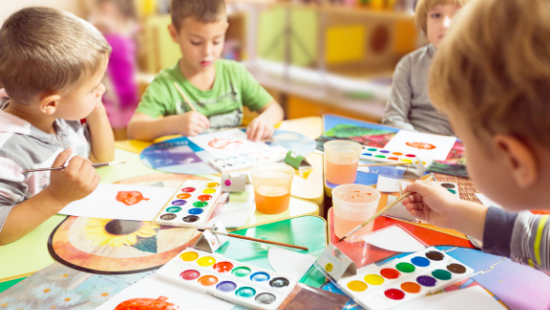
Preschool Readiness Checklist
While all the above information will help you prepare for preschool, this list will help you in deciding your child’s readiness and serve as a great checklist for practicing the skills you child will need.
Language Skills:
- Say their name and age
- Speak 250 to 500 words
- Answer simple questions
- Speak in sentences of five to six words, and speak in complete sentences by age 4
- Speak clearly, although they may not be fully comprehensible until age 4
- Tell stories
- Uses language to communicate with others for a variety of purposes (for example, describing something, making requests, greeting someone, etc.)
- Speaks clearly to be understood by others
- Uses accepted language and communication styles (for example, using polite manners, using appropriate volume and tone)
- Uses accepted nouns, verbs and adjectives in familiar contexts
- Understands words for common categories (for example, toys, food, clothes)
- Holds a book properly and turns pages
- Understands that words convey the message in a story
- Recognizes the first letter of their own name
- Knows some letter names
- Knows the main characters in familiar stories
- Enjoys reading books with others
Cognitive Skills:
- Correctly name familiar colors
- Understand the idea of same and different, start comparing sizes
- Pretend and fantasize more creatively
- Follow three-part commands
- Remember parts of a story
- Understand time better (for example, morning, afternoon, night)
- Count, and understand the concept of counting
- Sort objects by shape, color, and size
- Complete age-appropriate puzzles
- Recognize and identify common objects and pictures
- Identifies some shapes such as circle, square and triangle
- Understands and explores empty containers and full containers
- Recognizes and matches small quantities to the number words 1, 2 and 3
- Shows interest in numbers and recites some number words
- Can count along with help, although might make mistakes
- Distinguishes between “some” and “all,” and parts of a whole
- Uses some size words, such as “many”
- Uses words such as “same as” to make comparisons
- Shows interests in patterns and sequences
- Understands the order of the day, and begins to use some time words such as “morning” and “night”
- Matches like objects, mainly identical objects, or matches objects by shape and color
- Develops object permanence (understands that objects continue to exist even when out of sight)
- Shows interests in tinkering with objects by taking things apart and putting them back together
- Explores with elements of nature, such as sand and water
- Remembers short sequences of events of 2 to 3 steps
Gross Motor Skills:
- Walk up and down stairs, alternating feet — one foot per step
- Kick, throw, and catch a ball
- Climb well
- Run more confidently
- Ride a tricycle
- Hop and stand on one foot for up to five seconds
- Walk forward and backward easily
- Bend over without falling
- Help put on and remove clothing
Fine Motor Skills:
- More easily handle small objects and turn a page in a book
- Use age-appropriate scissors
- Copy circles (3) and squares (4)
- Draw a person with two to four body parts
- Write some capital letters
- Build a tower with four or more blocks
- Dress and undress without your help
- Screw and unscrew jar lids
- Turn rotating handles
- Holds a writing tool with a fist or finger grasp
- Draws with a variety of tools (crayons, pens, pencils)
- Scribble-writes in a linear fashion
- Makes marks and refer to them as “my name”
Social Emotional Skills:
- Imitate parents and friends
- Show affection for familiar family and friends
- Understands the idea of “mine” and “his/hers”
- Show a wide range of emotions, such as being sad, angry, happy, or bored
- Initiates and maintains independent play (for example, plays alone in the sandbox, or role-plays independently)
- Enjoys doing things on their own sometimes, such as reading, crafts or getting dressed
- Can separate from you for several hours
- Appears interested in going to a “big-kid” school, learning new things, and/or meeting new friends
- Enjoys participating in group activities
- Can express emotions, needs and requests
- Responds well to consistent routines, such as quiet time or naptime following lunch
- Anticipates what comes next during the day
Concentration Skills
Concentrating is going to look very different in a preschooler than it does in older children. You will also find that it varies vastly between children.
Look for things such as being able to pay attention to a short picture book, or focusing on an activity for 10 – 20 minute stretches. Your child will need to be able to focus on tasks and follow directions in order to make the most of preschool.
However preschool teachers also understand that some distraction is typical, and preschool is a great way to build these skills if your little one has had little opportunity elsewhere.
Stamina
Preschool requires a lot of physical and mental energy. If your child isn’t used to following a routine and being engaged, they may have a more difficult time adjusting to preschool.
A way to gauge if your child may possess the necessary stamina for preschool is to look at their sleeping schedule.
Does your little one still take long morning and afternoon naps? This may be a sign that they are not quite ready for the energy it requires to make it through a whole school day.
To prepare your little one you can try keeping them awake longer in the morning and offering one longer afternoon nap.
What You Can Teach Your Preschooler
If you’re not in the education field, you may be unsure of simple ways to teach your three year old or ways to incorporate new learning into everyday activities.
Practice and exposure is the best way to develop new skills with your child so try and make every opportunity a learning opportunity. You will find several ideas and examples throughout this blog post.
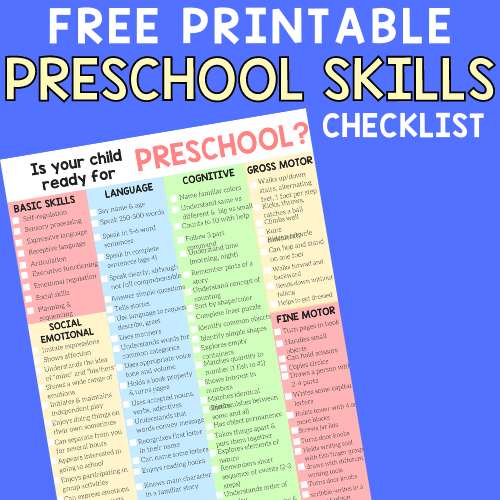
Ways You Can Prepare for Preschool at Home
If you are searching for a preschool readiness skills checklist, chances are that you are ready to begin practicing these skills at home. Especially if your child seems lacking in any of the mentioned skills.
Luckily, preparing for preschool at home is simple and many skills can be incorporated in your normal every day routines. Check out the list below for ideas on how to prepare for preschool at home:
Language and Reading Readiness Skills for Preschool
To avoid any confusion, your child does not need to know how to read or write before entering preschool, but he or she should show some form of readiness such as being able to recognize letters, understand how to hold a book, and participate in conversations.
1. New Vocabulary
Your 3-year-old will probably be speaking in full sentences or at least long 4-5 word phrases by now. Three year olds should have at least 250-500 words in their vocabulary as well.
Although there are way too many words to give you a full list, here are some of the common words, phrases, and concepts that your three year old should be able to say and understand:
- Body parts, Animal sounds and names, Friends/Family Names (and their own first, middle, last), Vehicles, Household objects (food, utensils, furniture, clothing, etc)
- Colors and Shapes
- Direction words (below, above, next to, on top, underneath, etc.)
- Days of the week, Months of the year, Seasons, Weather (sunny, rainy, cloudy, windy, snowy, hot, cold, etc.)
If your 3-year-old isn’t talking much at this point or is not trying to speak in full sentences, mention it to your pediatrician. Here are more tips to get your child to talk here.
2. Conversational Speech
Your 3 year old should be able to ask and answer simple questions and tell simple stories or anecdotes. They’ll probably be asking a lot of WHY questions as they are curious to learn all about the world around them.
Be sure to answer them with the correct responses and not just ignore their requests for information. Every question is an opportunity to teach your child and you don’t want them to miss out on those experiences.
It’s also important to make corrections in their grammar. When they were 2, some of the things that they said wrong sounded pretty cute. However, now that they’re 3, you don’t want them to get into bad habits of the way they speak.
Whether they’re pronouncing a world wrong, using the wrong tense, pronoun, or grammar, the only way they will learn the right way is if you correct them. So let them know the right way to say the word or sentence and have them repeat it back to make sure that they understand.
In order to get your child to initiate conversation or answer your questions, you can:
- Ask them about their favorite characters/shows/books/toys. What easier way to get a kid to talk than to get them talking about their favorite tv show or super hero?
- Ask them about their day, ie. what did you eat for lunch? What did you play with in the bath tub?
- Ask them for their opinions
- Tell them to ask you about the above mentioned things
If they still tend to give you one-word answers, ask them more questions to get them to elaborate. The more you ask, the more responses you will get. In turn this will help them to realize that they need to add more detail in their responses.
3. Reading books
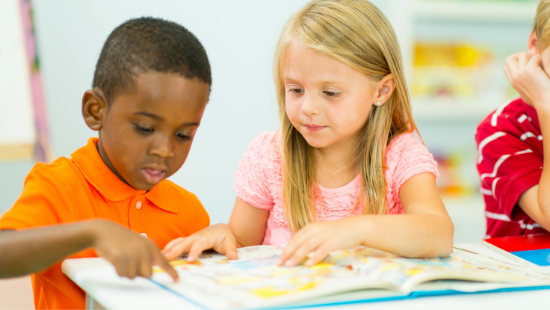
At 3, your child should understand the concept of “reading” a book. They won’t actually be reading the words, but they should know how to grab a book, hold it the right way, and flip through the page independently.
They should be able to get a good understanding about what is happening in the book by looking at the pictures. They should even recognize that there are letters and words on the page that mean something, but won’t know exactly what they say or mean.
Read to your child every day to instill their interest in reading. When you are reading to them:
- Use your finger to follow the words on the page so they start to associate the letters with what you’re saying
- Read word-for-word what the text says on the page instead of making up words or describing what the pictures look like
- Ask them questions about what they see on the pages
Your 3 year old may even be able to answer some inferential (why) questions (although this is a tougher skill), but it can’t hurt to try and ask them some of the questions. These are questions that the book doesn’t actually give the answer to, but the child has to think about their own answer or reason. For example, Why is the girl sad in this story? Why shouldn’t the boy have crossed the street? Why did the dog jump over the bone?
Reading doesn’t have to begin and end with books; labels on cereal boxes, words on toys, printed words on street signs, text on the television, or signs at stores are some examples where you can point out words and letters.
Related Post: The Outstanding Benefits of Reading to Babies and Toddlers
4. Letters and Sounds for Beginning to Read
Your child may already know many of the letters of the alphabet. At this age, they should probably be able to recite the ABC’s from memory (with some errors and help as needed).
Now you can work on recognizing letters, as well as the sounds they make. To make letter learning easier, try these tips to teach your 3 year old:
- Look at both uppercase and lowercase letters when learning. The lowers case letters are the ones that they will see more often when they read or see words.
- Point out letters to them everywhere: on cereal boxes, on street signs, on banners, and on snack bags
- When talking about a letter, always tell them the sound that it makes and a word that has this letter as its starter. For example M: say M says mmm for mom. Always have them repeat you to etch it into their memory.
- Use different sensory modalities to trace, write, or copy their letters. For example, writing them in sand, placing stickers inside the written letter, tracing the letter written in puffy paint with your finger, erasing the letters from a dry erase board, matching upper and lower case letters, etc. Here are some more fun sensory activities for letter learning.
- Sing songs that help them to remember the letters
- Use puzzles with letters for letter matching
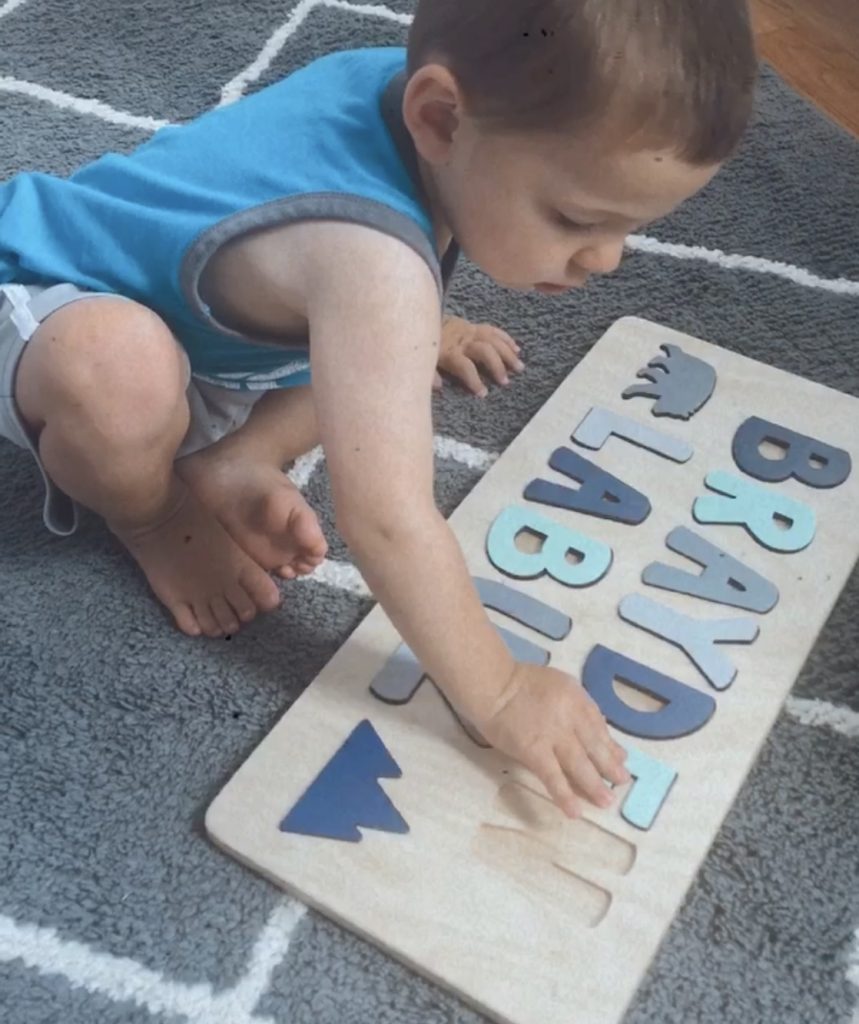
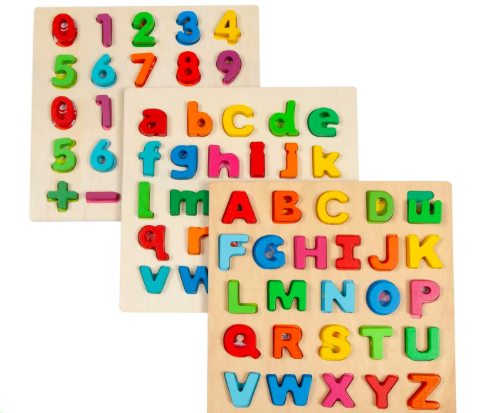
These name puzzles from Bloom Owl are a great way to get your child learning the letters of their name. They’ll love playing with the puzzle as they start to recognize the letters they see all the time.
By far my favorite resource for having your child learning letters and letter sounds is the Leap Frog shows on Netflix. They include Letter Factory, Phonics Farm, and more. If you have Netflix you can access these shows! My 20 month old was reciting all of the letter sounds because he loves this show so much!
Once your child has a good memory of most letters and their sounds, you can teach them how to put them together to form short words. At 3 years old, a child may be able to start reading 2 or 3 letter words. Teach them how to use those sounds to read short words from the -at, -et, -it families, such as mat, rat, bat, get, set, let, sit, fit, kit, etc.
Related Post: Sticker Activity for Learning Letters
5. Sight Words
The first sight word that your preschooler may be able to spell and recognize is their name. Teach them how to spell their name and how to recognize it when it’s written. Those name puzzles shown above are great for practicing this!
Although your child isn’t expected to know sight words until later on, it can’t hurt to expose them to it now. Sight words are words that may not sound the wya they are spelled so they will have to just memorize the way the word looks.
These are typically commonly used words, for example, like, the, and my. As you read to your child, you will probably come across these words several times.
Point out the words to them and tell them what they say. If you tend to read the same books over and over, they should quickly pick up on what a word looks like and say it as you read. Not only should you point these words out in their favorite book, but wherever you see it whether it’s a cereal box or sign.
Flash cards are also great for learning sight words, however they are a bit young for this.
Math Readiness Skills for Preschool
Math Skills for Preschoolers doesn’t look like algebraic equations or complex formulas. Rather, your child will show math readiness skills by understanding time, using words such as more/less, big/small, (or other comparing words), counting, doing puzzles, and learning days of the week- all of these skills can be practiced at home during normal day to day activities.
1. Sense of Time
Of course your three year old will not be able to tell time, however you can still teach them a basic sense of time, including:
- Understanding morning, afternoon, and night. They should understand the concept of when they wake up it’s morning, lunch time is the afternoon, and before bedtime is night. They can also understand this better by seeing outside when it’s light or dark.
- Recognizing the numbers on a digital clock. If they can identify numbers, they should be able to see the first number and say it’s 7 o clock. With my daughter, we tell her that 7 o clock is bedtime so when she sees 7 on the digital clock, she knows it’s time to go to bed.
- Knowing when they have 1, 5, or 10 more minutes left. They still won’t have a true sense of how long these increments of time are, but you can try to make them aware that 1 minute is quick, compared to 10 minutes or 20 minutes.
- Days of the week. They may be able to get a sense of what day it is today, what it will be tomorrow, and what it was yesterday
Before they fully have a sense of time, try setting an audio or visual timer when you need to show them when time is up. For example, when you say clean up in 5 more minutes, set a timer for 5 minutes to ring when it’s time.
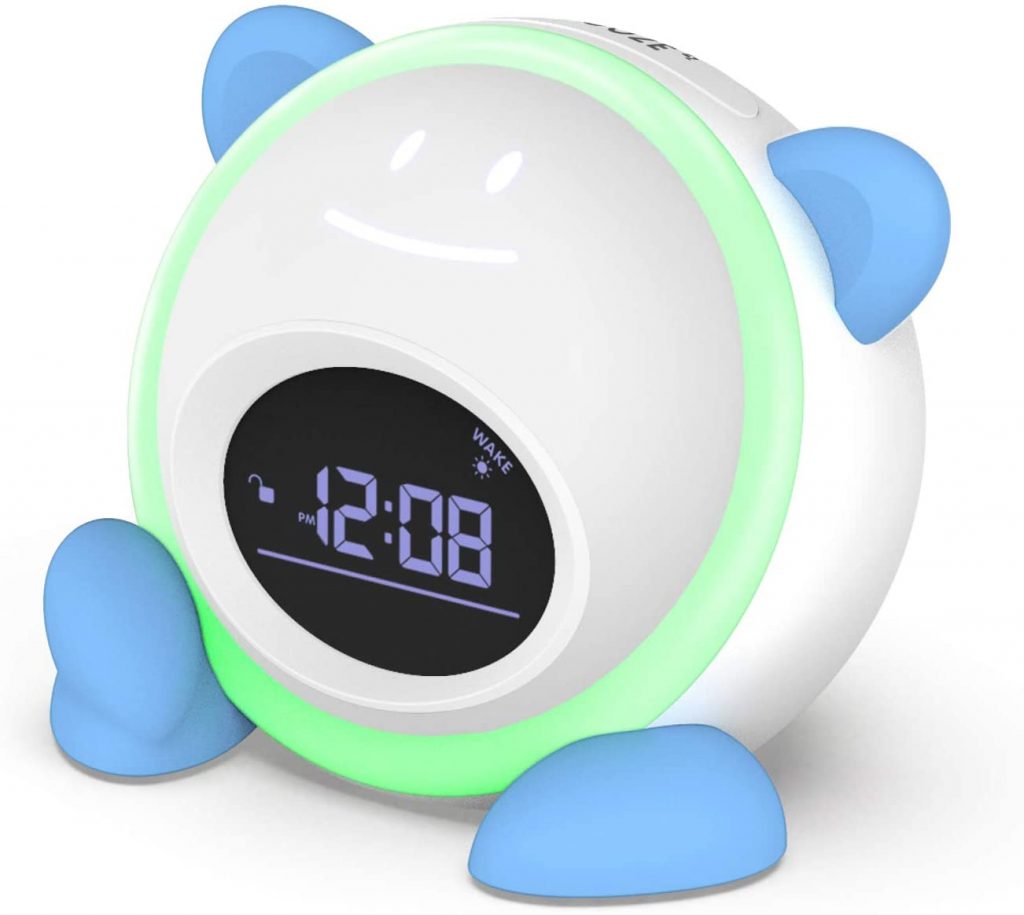
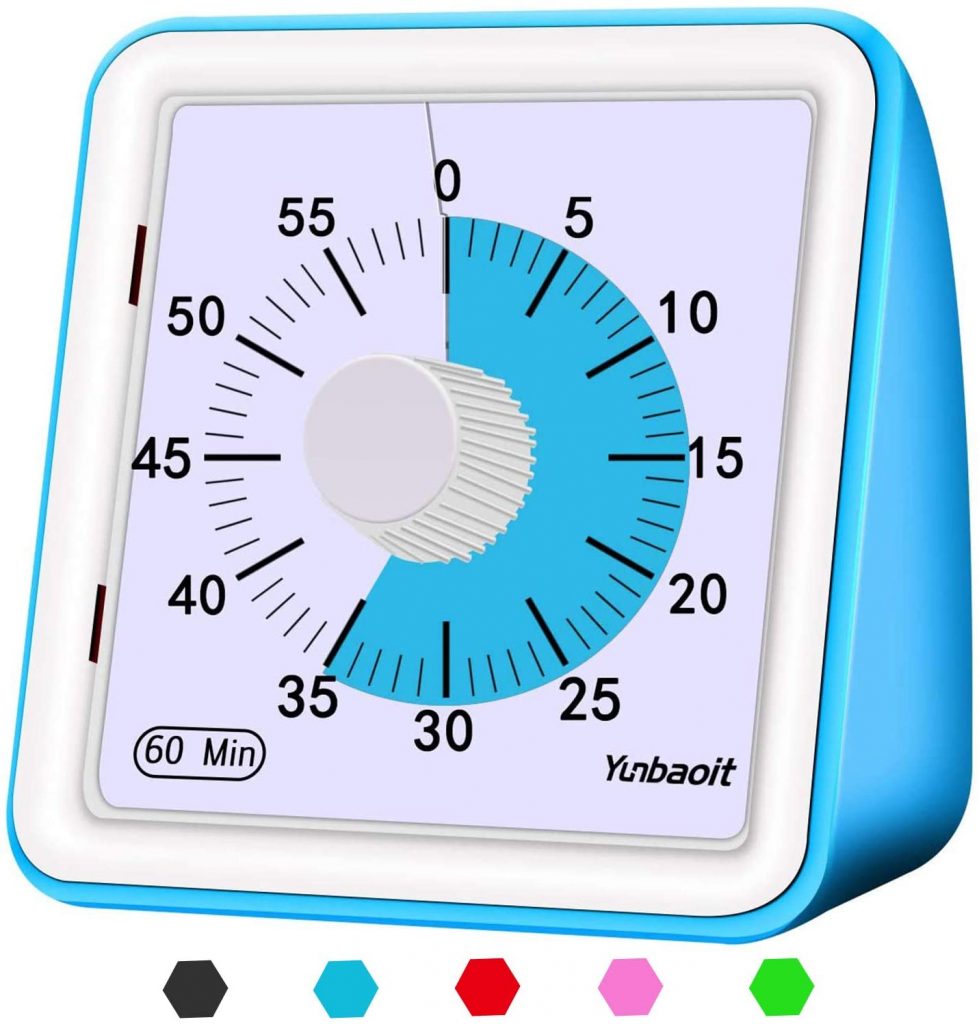
We love the Time to Wake clocks for my little ones. They let them know when it’s time to call for mom or get out of bed by simply turning a different color when it’s almost time to get up or when they should leave their room.
This is a great visual way for them to “see” and understand time.
2. Puzzles
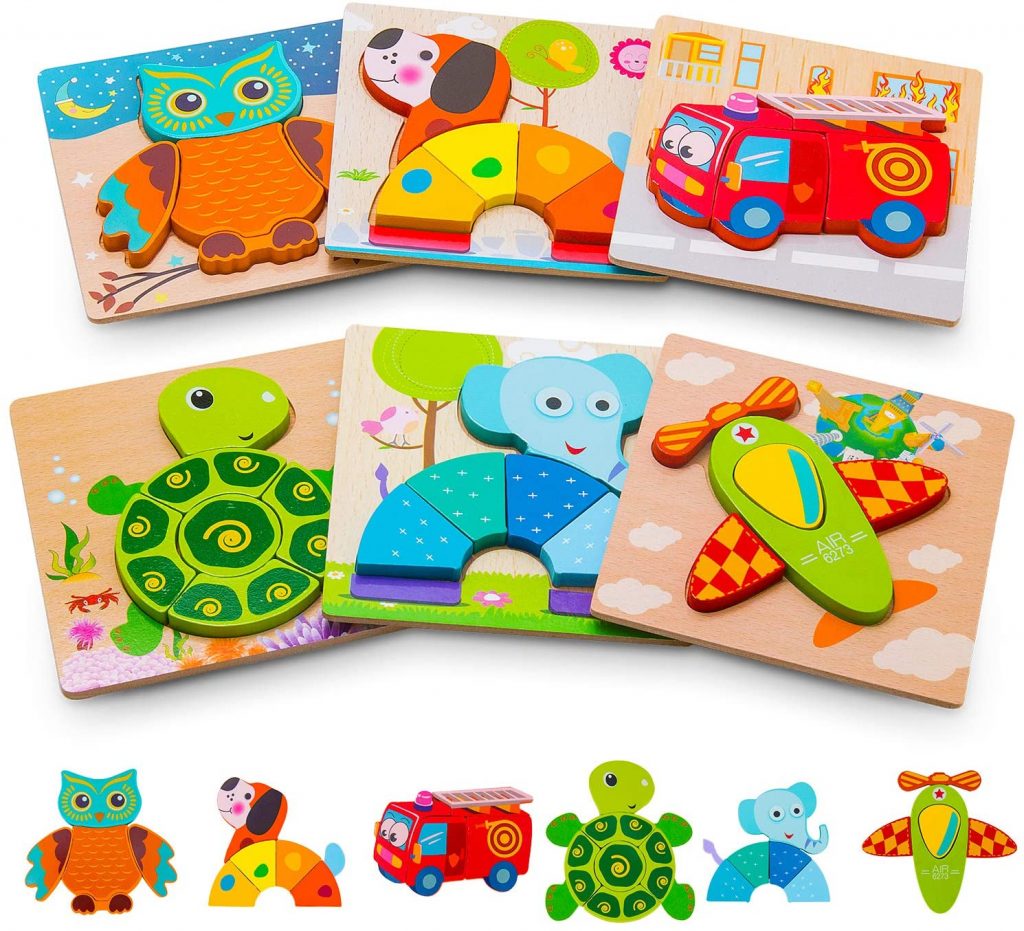
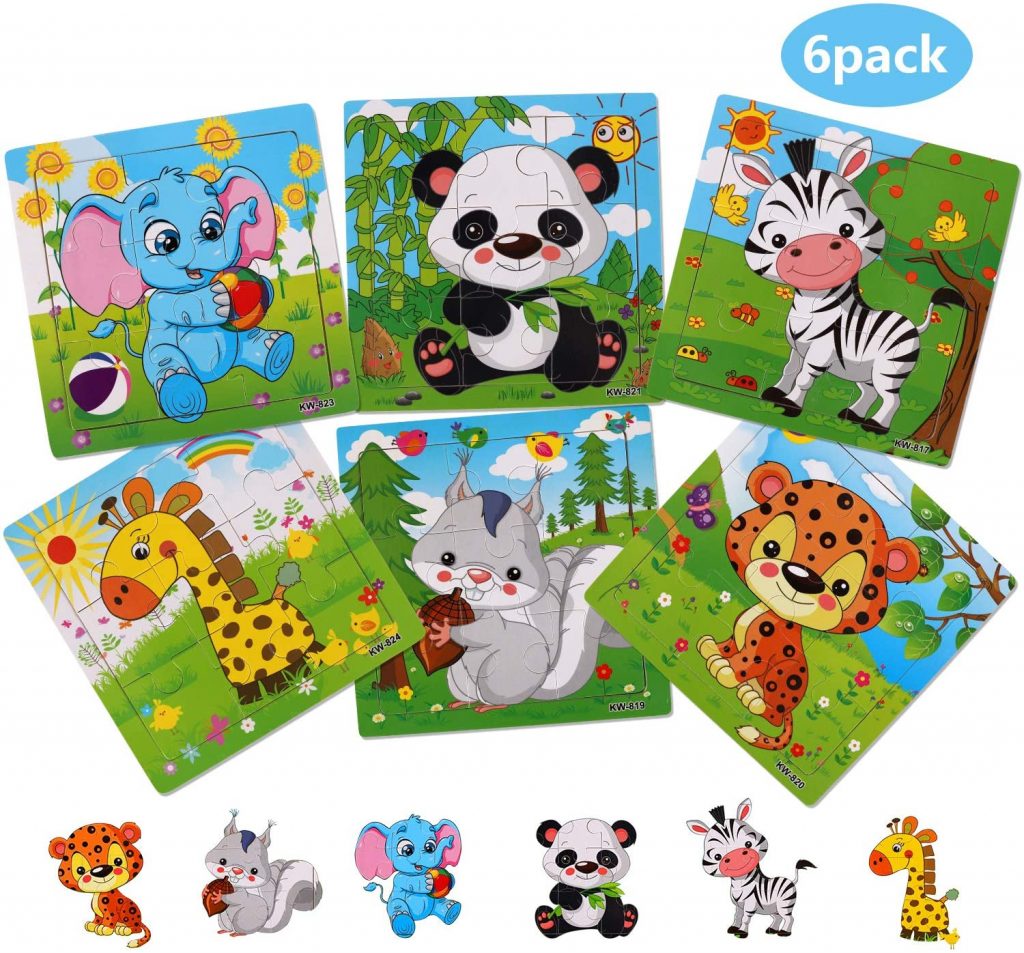
Puzzles are a great activity for fine and visual motor skills (hand-eye coordination). Having to fit a piece into it’s correct spot by turning and manipulating it is great for visual-spatial awareness.
Your 3 year old should have moved past inset puzzles and can do more complicated interlocking puzzles. Start them out with small interlocking puzzles like these or these, which only have 6-9 pieces per puzzle.
3. Numbers and Counting
Your 3 year old may be able to count up to 20 (with some errors at times) from memory and maybe even up to 30 with more practice. They can also work on recognizing and identifying numbers and counting objects.
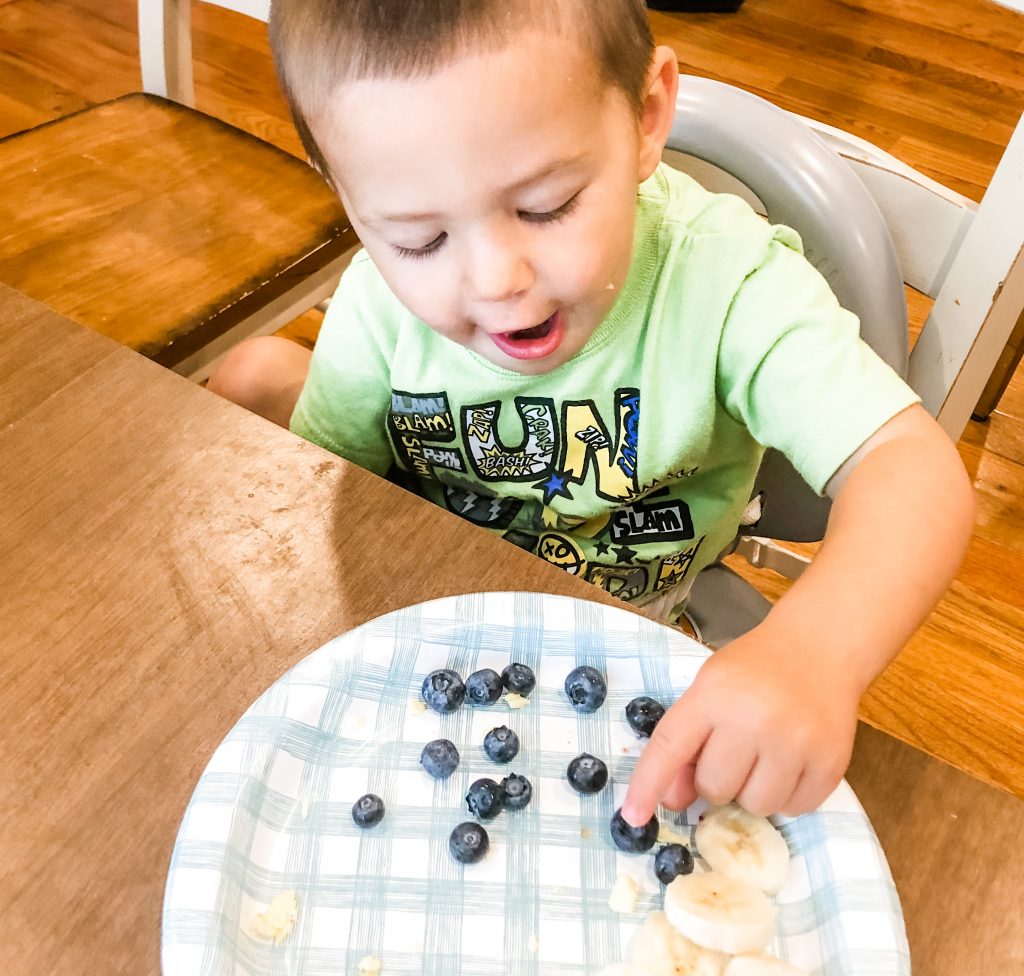
You can practice counting with so many different, everyday objects:
- count each step while you’re walking up the stairs
- count the number of blueberries on their dinner plate
- count the number of toys in their toy bin
Numbers are everywhere so be sure that they are counting whenever they can.
The concept of one-to-one correspondence (one object is one number) should be emerging now. Just show them how to point to each object as they count it and correct them if they start saying 2 numbers as they count one object or skip over objects when counting.
4. Sorting and Comparing
Sorting and comparing is a skill that you can teach your 3 year old. Make them aware of how objects are the same and different. Some of the criteria that they can use to sort is by:
- color
- size (big, medium, small)
- shape
- categories (fruits vs. vegetables, farm animals vs. ocean animals)
- pattern (stripes, polka dots, solids)
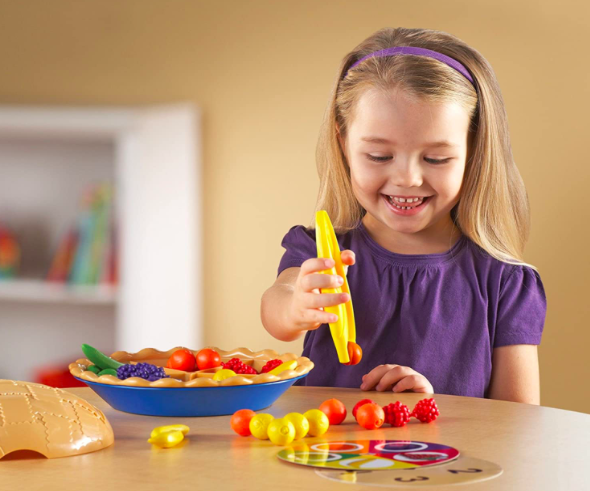
This sorting pie from Learning Resources is a great way to practice sorting
5. Days of the week/Months of the Year/Seasons
By going over the calendar daily or singing songs, your 3 year old can learn the days of the week and months of the year pretty quickly. They still may not get a true sense of how these time periods work, but they can memorize a list of these items.
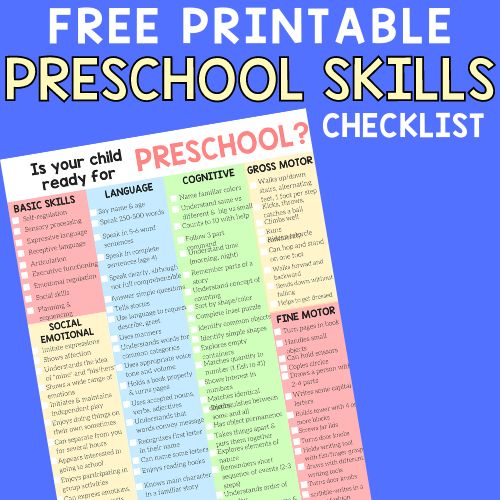
Motor Skills for Preschool Readiness
Your child should be proficient in several different motor skills at this point in development. Gross motor skills are apparent by your child’s ability to run, jump, hop, and skip. Your little one should also be able to navigate around different objects. Many of these skills can be practiced by trips to the local playground. Your child should also have fine motor skills such as hand-eye coordination, and working the finer muscles in their hands/fingers.
1. Physical Activity, Sports, and Getting Outside
Three-year-olds are known to be pretty wild so you probably won’t need much coaxing to get them active. However, make sure they’re getting plenty of physical activity to learn new gross motor skills. These include:
- Jumping and running
- Climb up and down playground equipment or a jungle gym
- Start learning how to ride a balance bike or a bike with training wheels
- Throwing/catching/kicking a ball
- Hop or stand on one foot for a short time
- Walk backwards
The best way to get them active is to give them lots of outdoor time. Take them to playgrounds to climb on the equipment as they offer so many opportunities for enriching gross motor skills. Take them for a walk and point out all the sights you see.
Your child can also start playing cooperative sports with peers and follow directions by watching someone do a movement. Activities like gymnastics, dance, soccer, swimming lessons, and tee ball are all great organized activities to practice all of the above skills.
2. Cutting
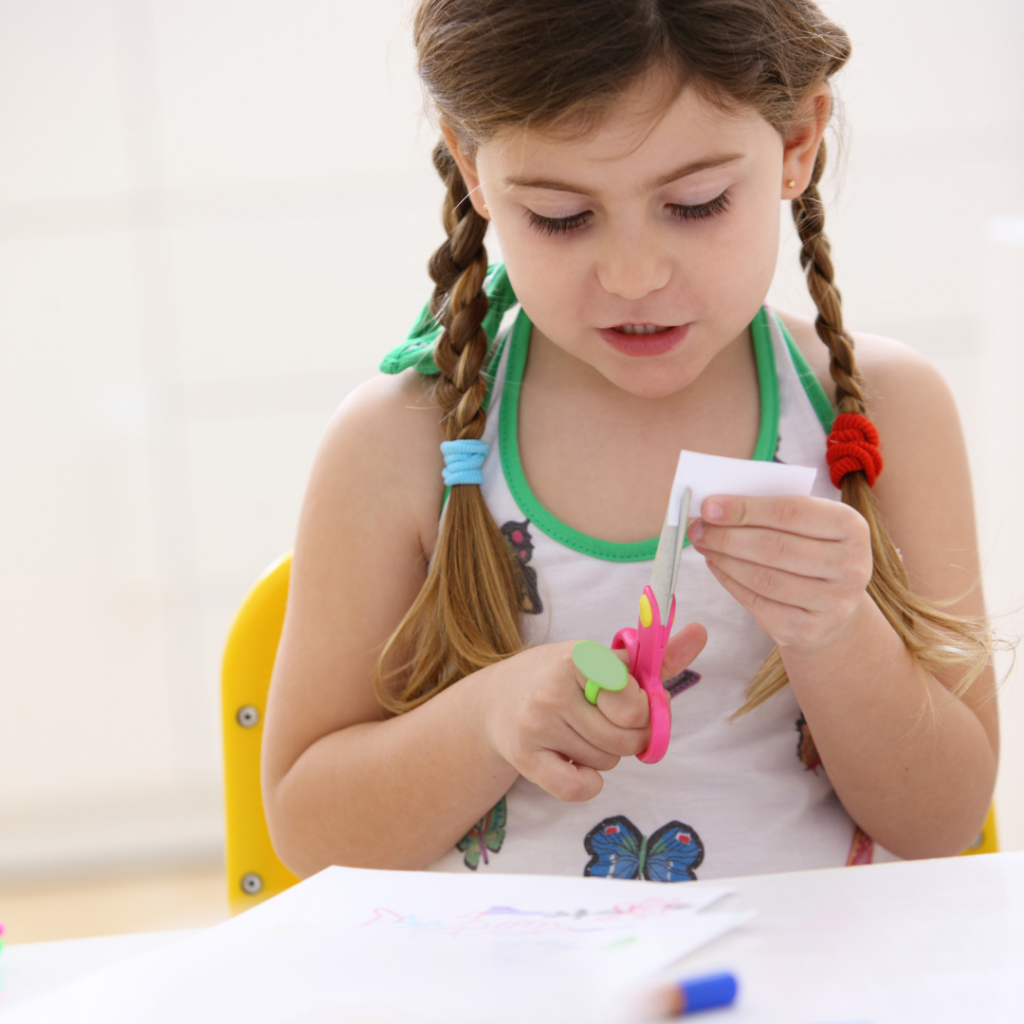
Cutting is a skill that 3 year olds can begin practicing. They may still have a difficult time, but here are some tips to get your preschooler cutting:
- Be sure to use child safety scissors so they can’t hurt themselves.
- Teach them how to hold the scissor correctly with their thumb toward the ceiling on both the cutting hand and helper hand
- Position the paper in front of them while they are cutting instead of holding it off to the side or way up high.
- Make sure that their arms, shoulders, and elbows are down and relaxed as they cut right in front of them. As they’re concentrating, children tend to hike up their elbows and cut up high.
- Once they are able to make small snips on the paper by just opening and closing the scissors, teach them how to cut on a straight line
- Use sturdier paper like construction paper to make holding and stabilizing the paper easier on them.
3. Drawing
At 3 years old, your child should have moved passed scribbling and be able to make intentional marks on the paper. They should be able to draw a:
- straight line down
- straight line across
- circle
- cross ( + )
- other shapes such as a square or triangle come later, but they can still attempt these, but may need help or the angles won’t be perfect
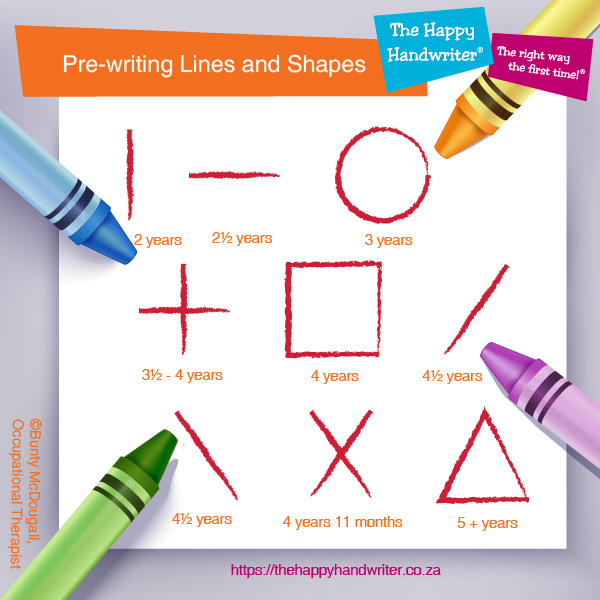
You can also guide them into making drawings using those elements (lines and circles), for example to draw a sun, a person (stick figure), or a flower. Of course, these drawings won’t be perfect, but they’re gaining insight as to how to make their marks on the paper look like something real.
Imitation is the best way to have your child learn to draw at this age, meaning that you draw one line and have them watch and repeat the same thing. This as opposed to copying (where you just show them the picture and expect them to figure out how to draw it).
4. Coloring and Painting
At age 3, your child can start learning how to color a picture correctly. You can guide them by showing them how to:
- Stay within the lines of a shape, border, or object
- Finish coloring each section without leaving a ton of white spots
- Use correct colors for certain objects, ie. coloring a strawberry red and a horse brown, instead of just picking any color that they choose
- Use different colors for different sections of a picture, ie. Coloring a beach scene with blue for the water, yellow for the sun, green for the palm tree, etc. instead of jut coloring the whole thing one color
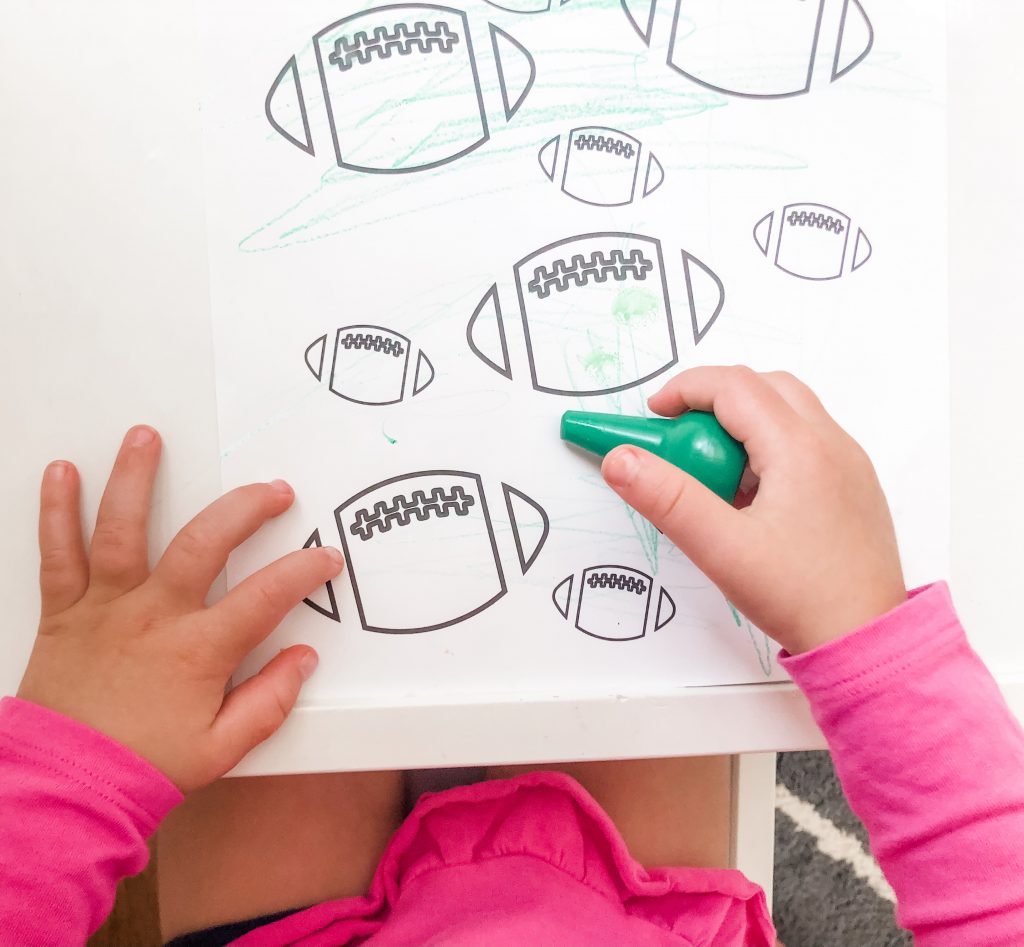
Be sure that they are holding their crayon with the correct grasp at all times. I highly suggest these finger crayons for the young ones. They are perfect for little hands and promote a good grasp when holding the crayons.
If your child likes markers, but you don’t trust them being alone in a room with them, these Crayola Mess-Free Coloring Sheets are my absolute favorites!
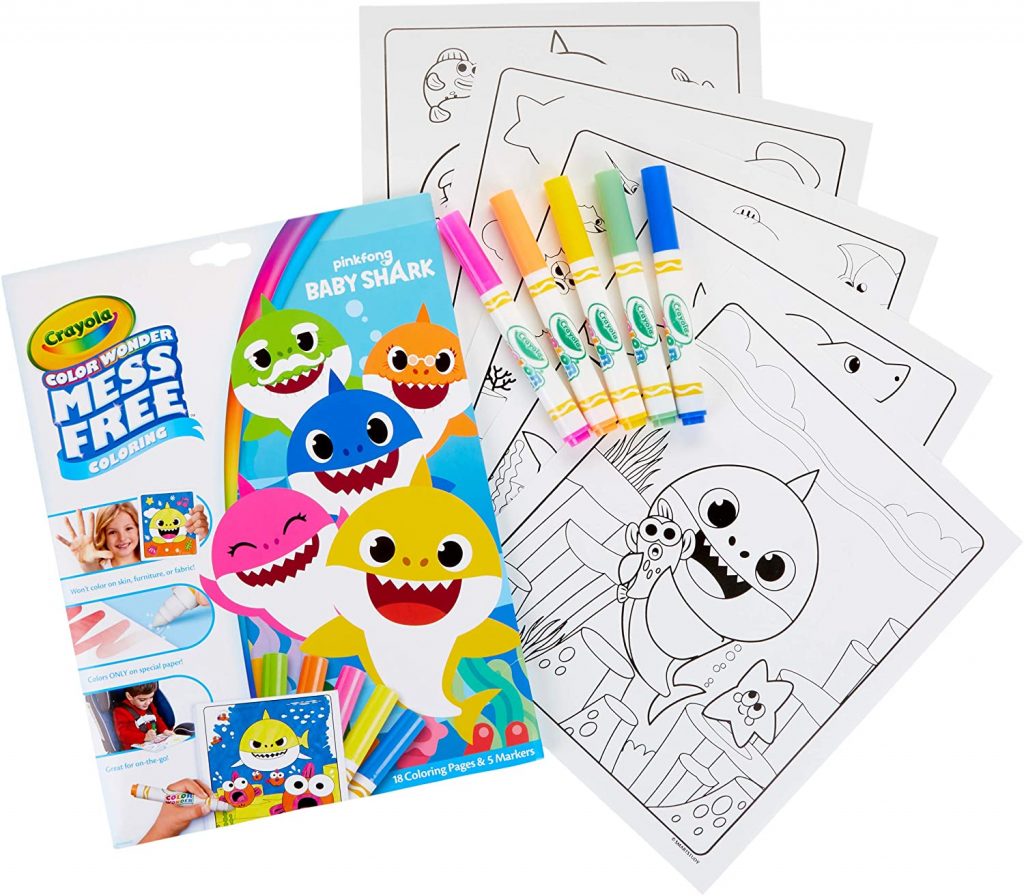
The markers come out clear if they are used on any other surface besides the paper. On these special sheets, they’ll turn a color so your toddler sees the masterpiece that they are creating. They have so many characters available so I’m sure you can find a pack that your child will love.
5. Tracing
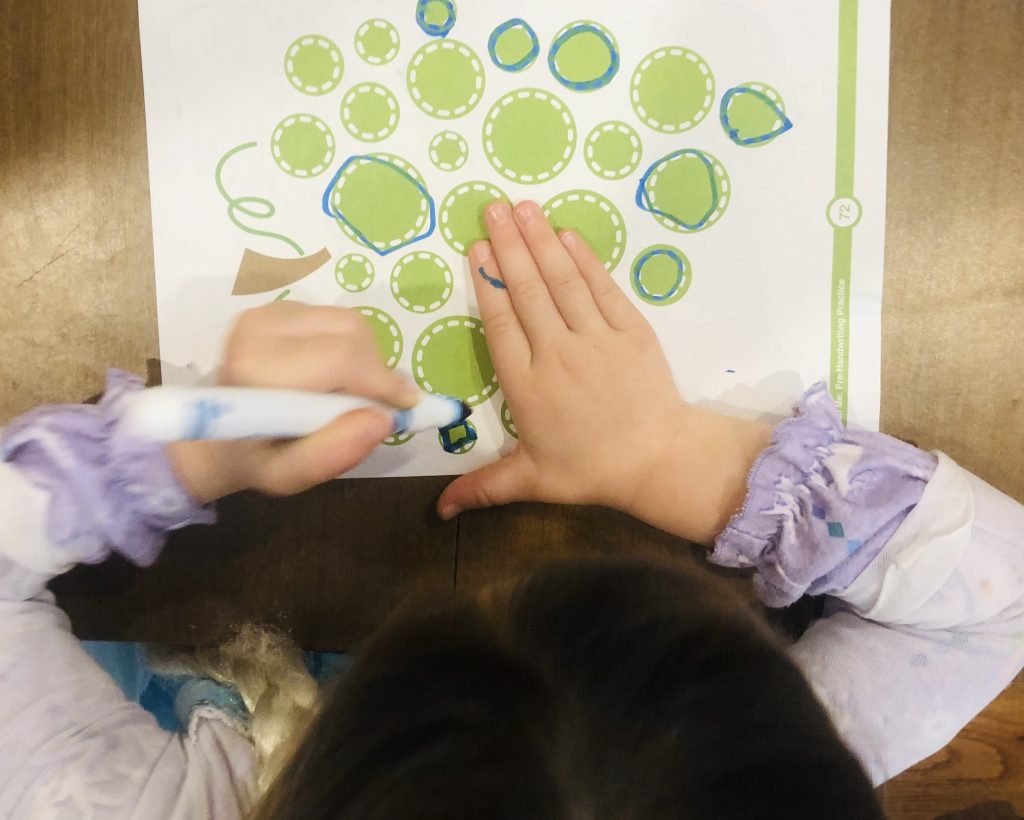
Tracing is a great visual motor skill (hand-eye coordination). You can teach your 3 year old to trace lines and letters by:
- Having them use their finger first to trace the line on the paper
- Tracing straight lines first and then working toward shapes, zig zags, and curved lines
- Making sure that they know to stay on the line the best that they can
- Tracing letters in preparation for writing
Social / Emotional Preschool Readiness Skills
Preschool teachers often see so many children come into my classroom who are not fully equipped for dealing with things on their own, without their parents – this can cause some major challenges. As such, social/emotional skills are essential skills for preschool readiness.
1. Promote Independence
Your three-year-old should be doing many things on their own now so be sure to give them these opportunities to learn, understand, and make mistakes (within limits, of course).
Of course they may not have perfected every skill yet, but the only way a child will learn is by doing it themselves. You can give them a hand completing the task once they’ve finished.
They should be increasing their independence in areas like:
- Dressing: choosing their own clothes, dressing for the weather (warm items or cool items), taking on/off a shirt, pants, underpants/pull-up, shoes, and socks, and learning the right way to put on items (backwards, forwards), and that shoes are on the right feet.
- Self-feeding: using utensils without spills, choosing their own meals and snacks, opening containers, drinking from an open cup with some supervision, and why it’s important to eat healthy. I love these utensils as my 3 year old graduated from her “baby utensils” to wanting to be just like mom and dad- these look like our silverware but are a perfect size for preschoolers.
- Brushing teeth and hair: Teach them how to brush correctly on their own (back and forth, top and bottom), putting toothpaste on (with help), and why it’s important to keep our teeth clean. My 3 year old LOVES using an electric toothbrush like this one, especially the ones with their favorite characters.
- Cleaning up: wiping up messes, putting toys away, bringing dishes, cups, & utensils to the sink when done, throwing away their garbage, using handheld vacuum to clean, and putting away toys when completing activity
- Hygeine: Blowing their nose, washing their hands, using a washcloth to wash themselves in the tub. Make washing hands and standing at the sink much easier by using stools and sink faucet extenders.
- Transitions: Getting in and out of the car on their own, going up and down the stairs, ending one activity and moving to the next without complaining, turning on/off lights when entering/leaving the room
Be sure to model and show your childhood to do these skills the right way so that they don’t keep practicing something the wrong way.
2. Pretend Play
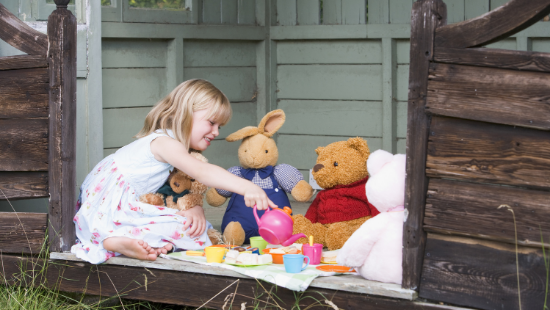
Using their imagination opens up a world of fun and play for your 3 year old. This skill typically comes naturally as they copy and imitate what they see in the real world, in books, or on tv.
They will use a combination of imagination and reality to copy the things they see daily, like these:
- Cooking in a play kitchen with pots and pans
- Hosting a tea party for their dolls and stuffed animals
- Feeding, burping, and changing a baby doll with play spoons, bottles, and diapers
- Talking on the phone with a play cell phone
- Playing doctor with a doctor or nurses kit
- Going shopping with a shopping cart and fake food
- Driving a car
- Sweeping, mopping, and vacuuming the floor
- Dressing up as their favorite princess, super hero, or character
2. Safety
Of course, safety is a crucial lesson to teach your child. This is the age where they will probably have no fear or understanding of dangerous situations. The following practices need to be taught to your 3 year old as they may not just come naturally:
- not running away in public
- not running out into a parking lot
- stranger danger
- staying close to mom or dad
- being cautious when crossing streets
- holding hands when in public or outside
- sun safety: applying sunscreen, wearing hats
- being careful of hot items: kitchen appliances, flames, etc.
Speaking of safety for your little ones, the Whystle App is a great resource for all parents to have that tracks all safety information that’s important to your family. This includes product recalls for toys, food, and more that could promote dangers into your home. Download this app free on your phone and then there’s a free trial for the subscription so you never miss an important safety warning.
3. Manners and Respect for Others
Understanding how to properly treat others is a valuable trait to instill in your child. This goes for respecting both adults and other children. It’s important to teach your children how to use polite words and actions to show manners.
At this age, they are still testing their boundaries and exploring new ways of getting what they want. Instill rules for respecting others even through times of frustration.
- Saying excuse me when needing someone to move or get their attention
- Patiently waiting for a parent to finish talking to another parent before chiming in
- Saying please and thank you shows consideration and appreciation
- Making eye contact when speaking to others
- Apologizing when you do something wrong
- Ask questions to others about how their day is or how they are feeling
- Compliment others on their clothes, hair, or something they did
- Share their toys or items that belong to them
- No pushing, hitting, biting, or pulling hair to hurt others in any way
4. Acting Appropriately in Public and Understanding “No”

Preschoolers are very ego-centric (only care about themselves). It’s totally normal for them to only think about how things will affect them. This almost always leads to inappropriate behaviors as they learn what behaviors get them what they want.
Don’t always give in to every cry and teach them that sometimes they can’t get everything that they want. Don’t always give them the cookie that they’re begging for or the new toy at the store. If they must get the object that they desire, make them earn it.
Teach your 3-year-old how to act appropriately to avoid tantrums in public. Try putting rules in place when you are out so they know what is expected of them. Always have a way to redirect or distract them when you see a tantrum starting (using something else they are interested in). Lastly, just avoid situations that could set them off.
This is a great article about Tips for Cry-Free Shopping with Your Toddler
5. Empathy and Compassion
From a young age, you want to fill your child with compassion and empathy for others. Teach them about emotions and to be conscious of other people’s feelings.
- If they see someone crying, ask what’s wrong.
- If they see someone alone, go over and play with them.
- If they see someone that looks different than them, treat them equally.
- If they hurt someone, apologize and make it better
It’s never too early to talk to your children about race, ethnicity, disabilities, and recognizing differences between others.
6. Structure and a Routine
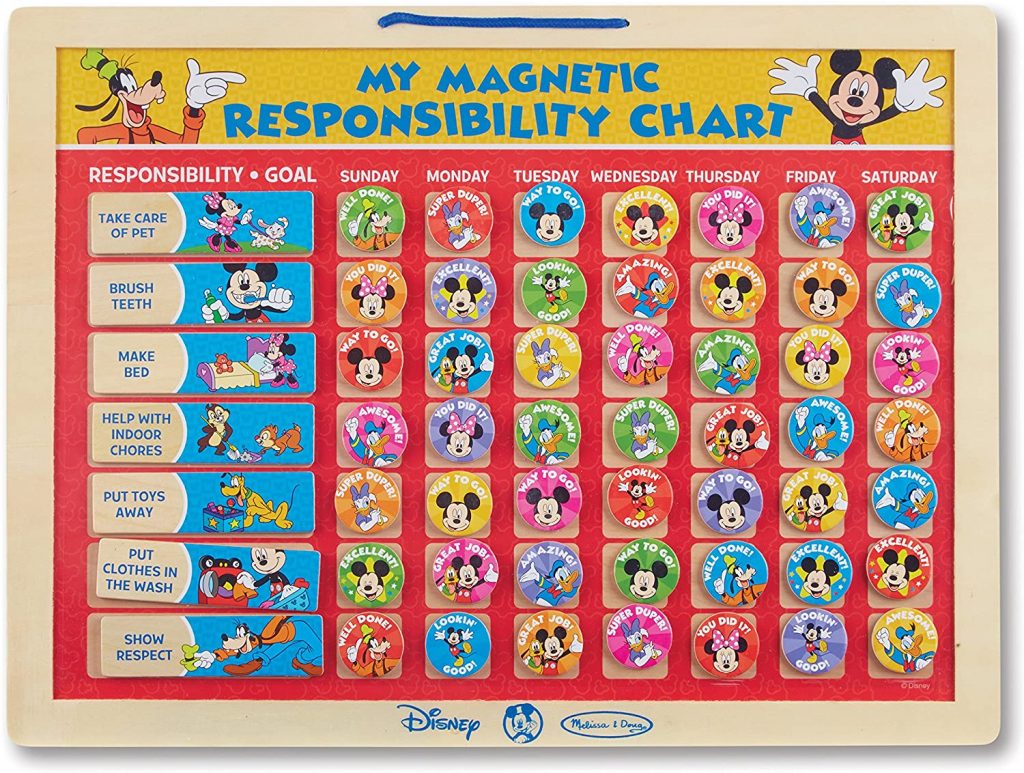
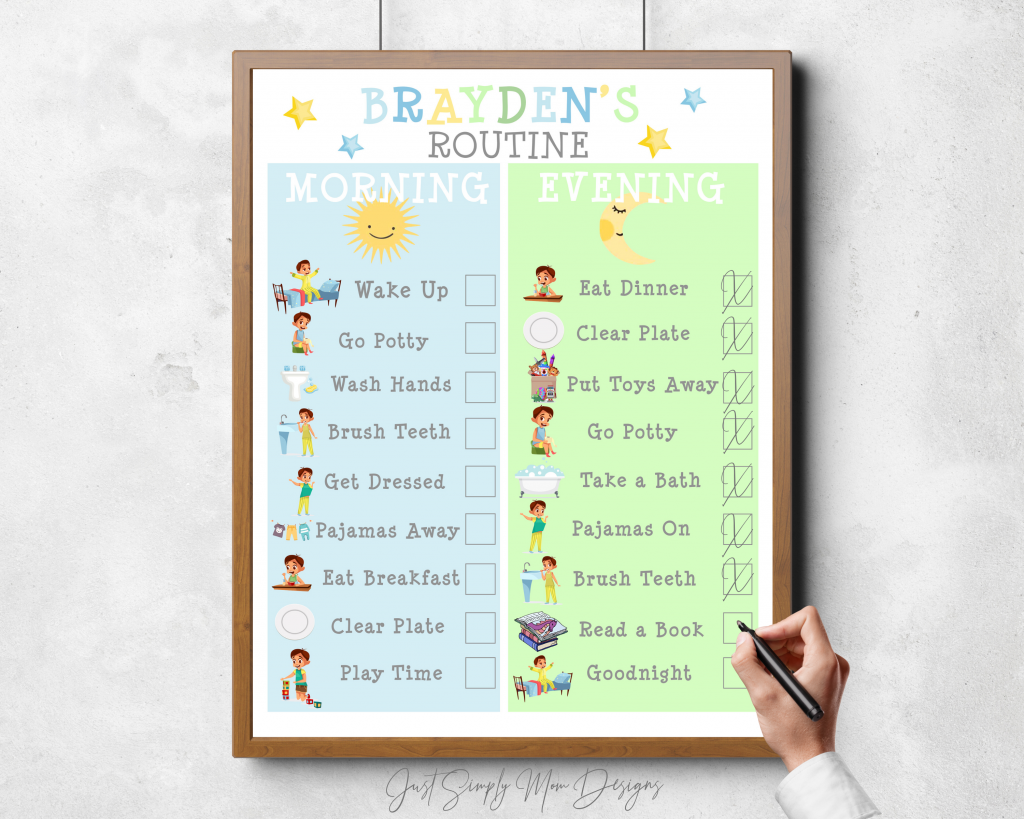
Your 3 year old probably already has some routine in place throughout their day. However, you want to ensure that they are consistently doing what is asked of them so that they could even do it on their own if needed.
The more structure that your child has in their day, the more they will start to understand time and a daily schedule.
I love using a routine or responsibility chart (like the blue/green one on the right) so my toddler can have a visual cue of everything that is expected of her. Use one with pictures instead of just words, (like this Mickey Mouse chart), so your toddler actually understands what it’s for.
Here are some examples of day-to-day routines that you can create a specific pattern for:
- Bedtime: Brush teeth, go potty, wash hands, put pajamas on, read a story, go to sleep
- Morning: Go potty, wash hands, brush teeth, get dressed, eat breakfast
- Before naptime
- Pre-dinner wind-down time
- Cleaning time
- Getting ready for school/daycare: Packing their backpack, putting their jackets and shoes on, getting themselves into the car
Related Post: Why Your Child Needs a Daily Routine and How to Make One
7. Staying on Task
A 3 year old’s attention span is still quite short, although it should have increased a lot since toddlerhood. It’s only reasonable to ask them to focus on a task for around 6-10 minutes at this age.
However, it is important for them to be aware that once they start a task they should finish it to completion. My daughter loves to grab a puzzle and put in 3 pieces and walk away or sit down and read 2 pages and then walk away.
The goal of teaching your child to stay on task is to complete what they start. Here are some tips:
- While playing with your child, make sure that they complete the entire activity, ie. puzzle or read through the whole book, before they get up and run around.
- If they’re coloring or building a tower, keep them engaged in that one activity for as long as possible before you let them move on to the next.
- During mealtimes make sure they remain seated and finish their meal before getting up and playing.
- Make sure they clean up one activity before moving on to the next
8. Be a Helper and Doing “Chores”
Little kids LOVE to help grown-ups. They want to do everything that you’re doing because they’re starting to gain this growing confidence and independence. Invite them to perform tasks that they may not be able to do independently, but that they can help you with.
- Get the mail
- Take the trash out
- Refill the toilet paper roll dispenser
- Help with cooking: mixing, adding ingredients
- Carrying in bags or groceries
- Fill the dog bowl
- Entertain a younger sibling
- Cleaning up their toys
- Cleaning up after themselves: throwing their dishes in the sink garbage in the trash can
- Wiping down the table or floor when they make messes
9. Follow Multi-Step Directions
Your 3 year old should now have progressed from only understanding and following 1-step directions (i.e. put your shoes on) to following 2-3 step directions (i.e. get your shoes from the closet, put them on, and go wait by the car).
Practice with 2 steps at first to make sure they can focus on the direction given, process it, and carry it out. Then you can try adding in another step to see if they can still follow.
At times, your little one may be distracted to get all the distractions, and that’s ok since their attention span is still short, but as they approach 4, they should really be listening to you intently and follow your commands.
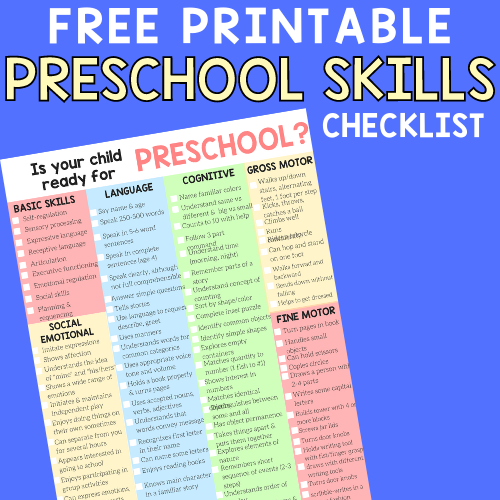
Health & Hygiene Preschool Readiness Skills
Depending on the preschool you choose the requirements may vary, but health & hygiene skills are extremely important. Your preschooler should know how to use the toilet and perform basic hygiene skills before enrolling in school. However, you shouldn’t worry about accidents, or your child needing basic instruction as preschool teachers are trained for these instances.
1. Potty Training
Around 3, many children will be fully capable of using the toilet. If you haven’t started yet, give it a try! Your child may do better than you think.
If they’re already potty trained, make sure that they are fully independent with pulling their pants and underwear up and down, wiping themselves both back and front, and washing their hands afterward.
Be sure to wait until they’re ready and don’t force it on them.
Here are some great tips on potty training your child here.
2. Staying Healthy: Good Hygiene and Eating Well
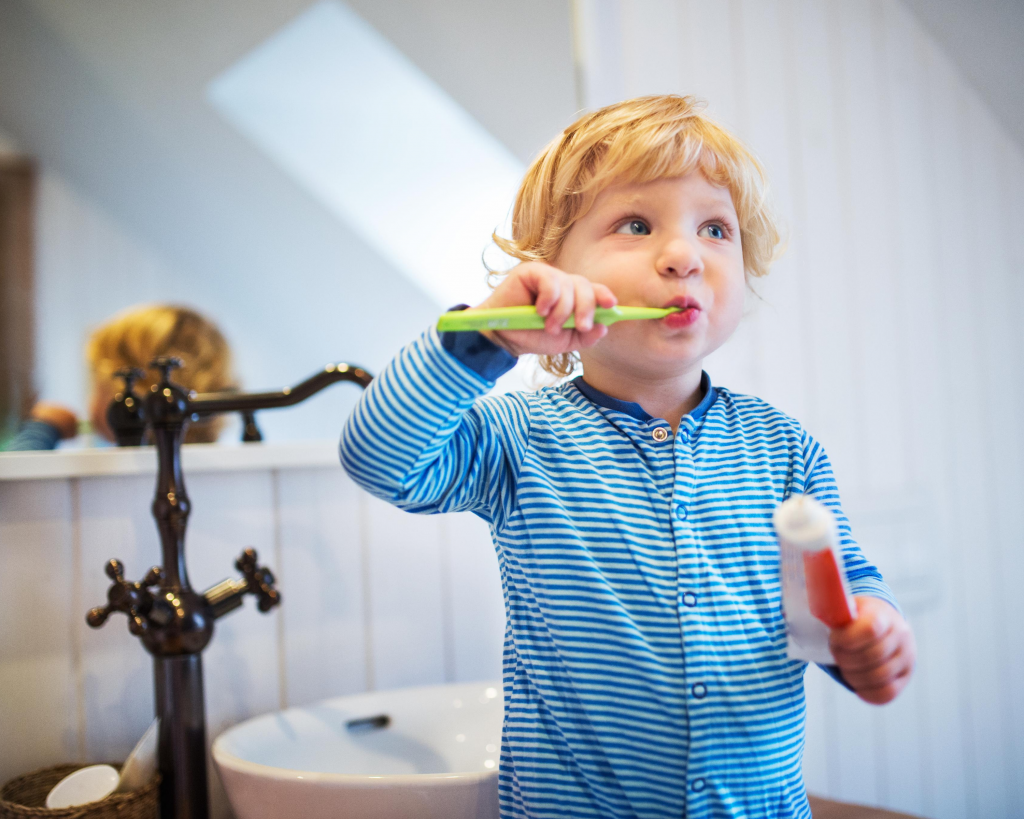
Teaching your 3 year old to practice good hygiene and healthy eating is great to start young. Build-in their hygiene routine throughout the day and they will become accustomed to this regimen. Eating healthy foods early on to set them off for a healthy diet for the rest of their life. These include:
- eating fruits, vegetables, whole grains, and proteins. Avoid: processed foods, unhealthy snacks, and sweets
- washing hands after meals and potty
- brushing teeth morning and night
- bathing daily or every other day
- keeping their clothes and body clean while they eat or play
- covering their mouth when they sneeze or cough
- blowing their nose into a tissue
- wiping their own privates after going potty
Complying with:
- brushing and combing hair
- cutting fingernails and toenails
- cleaning inside ears with a child safety q-tip
Related Post: How to Get Your Picky Toddler to Try New Foods
How can I Tell if My Child has Problems With Preschool Readiness?
Do you feel like your child may be having difficulties with preschool readiness? If your child has problems with preschool readiness they might show the following signs:
- Get easily frustrated
- Struggle to follow instructions
- Rely on parents/teachers to perform self care tasks for them
- Not be toilet trained
- Have issues with social skills
- Have little understanding of simple questions
- Have difficulty speaking sentences
- Respond in only short sentences
- Be difficult to understand or only parents understand
- Have a difficulty understanding consequences of their behaviours
- Not be interested in looking at books or participating in short activities
- Have few play skills
- Doesn’t like new activities
If you’re concerned about your child’s skills, or readiness for preschool you should speak to your pediatrician. Most of these skills listed above can be accomplished at some point while a child is between two and four, but every child develops at their own pace.
This article is not intended convince you into thinking that your child MUST know these ALL these concepts. However, if you are looking for signs of preschool readiness, ways to engage their mind, or knowledge to teach them, these are some great tips.
Your child is NOT behind if they can’t adequately do all of these things. Each child will enter preschool at different levels of readiness.
Have fun teaching your three-year-old and enjoy watching them blossom this year. They’ll be growing and developing before your eyes so don’t blink! Here are some more great activity ideas to do with your little one.
Please click here to follow me on my new Facebook Page for more updates on new freebies, articles, tips, and activities for your little ones!
